One of the most salubrious of restaurants in the West-End of London during the Jazz Age was the Devonshire Restaurant. It opened in late 1926 but despite an excellent cuisine, impeccable service and delightful décor it faltered and only lasted until the Spring of 1928. But then it was relaunched several times and did find success as the San Marco in the 1930s.
The idea for the Devonshire Restaurant had been on the cards for a number of years. It was built on part of Devonshire House that had been the town house of the Dukes of Devonshire from the 18th century but had stood empty after World War 1.
Finally, the old buildings, opposite the Ritz Hotel between Berkeley Street and Stratton Street were demolished and in 1924-1926 Holland, Hannen and Cubitts, a major London building firm headed by Lord Ashcombe built a new office building on the site. Fronting directly onto Piccadilly, it was also known as Devonshire House. The building became the UK headquarters of the automobile manufacturer Citroën, with showrooms occupying the lower three floors. Citroën remained the chief occupant of the building until 1936. At the back, with an entrance on Mayfair Place, the restaurant materialised apparently on the site of the ballroom of the original Devonshire House and opened in late 1926.

It was noted that Lord Ashcombe’s heir the Hon Roland Cubitt was taking a great interest in the new Devonshire restaurant as one of the directors. The company that he was part of was called Mayfair Restaurant Ltd and had been formed in March 1926. Maybe he was the driving force behind the enterprise as part of the overall Holland, Hannen and Cubitts building scheme.
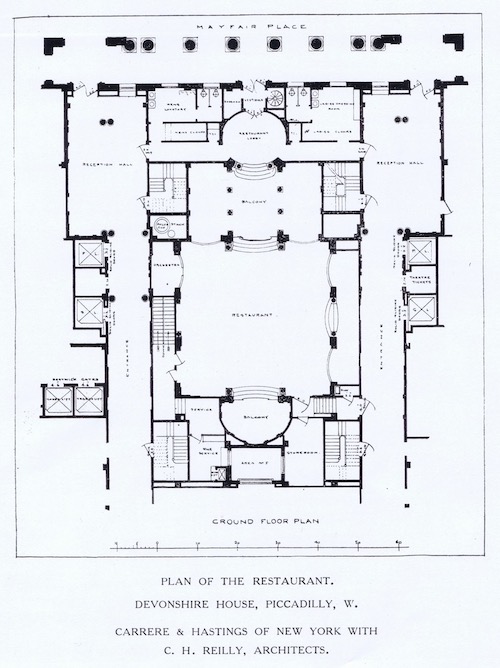
The entrance to the Devonshire Restaurant was via a magnificent portico described as ‘a thing of good lines, size and a fine frieze.’ There were two ornate lamps on either side. This frontage is perhaps is all that is left of the original restaurant and can be seen today.
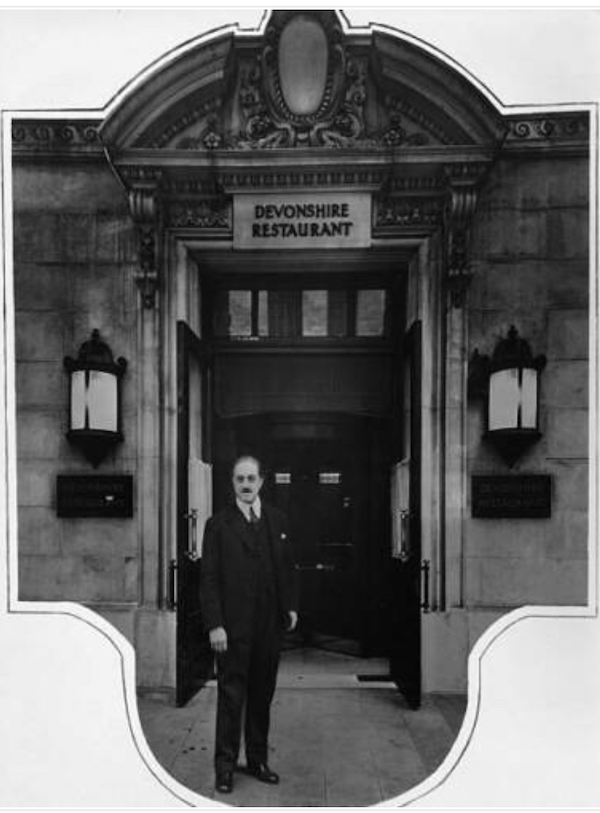
Once inside there was a small entrance hall that entered into vestibule with cloakrooms wither side and then a much larger square balcony with four pillars that served as a cocktail lounge. Below was the restaurant itself. The entire venue was decorated in pure 18th century neoclassical Adam style and recalled the arrangement of rooms at Sion house. It had distinction and beauty and was very salubrious. The walls were coloured a soft green, the colonnades were of amber-hued marble, the carpets were of grey-green vellum, classic statues peppered the rooms, there were mahogany doors, curtains and valances in pink and frieze-like panels in the Adam’s style. On the left of the room were three small side balconies (all connected) raised a few feet from the floor with tables and chairs and on the right was one balcony used as a stage for the orchestra which in the beginning was supplied by by Bert Firman and his band. At the end of the room was a special larger balcony.
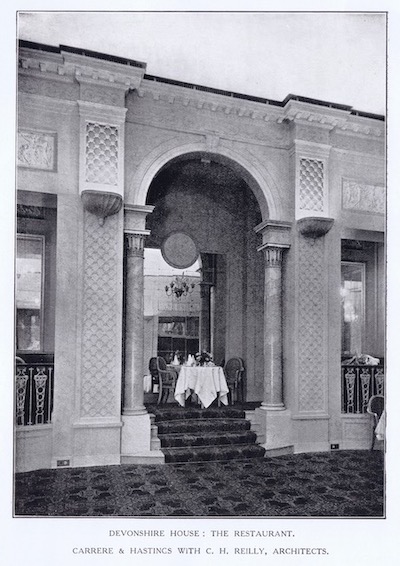
For one reviewer, the restaurant had appeared by a miracle lifted from some mansion built by famous brothers in the late 18th century. It was thought that there was ‘something wonderfully alluring about the Devonshire Restaurant; as a room it is just right, even to those who are not specially fond of Adam’s style’ and recognised that it had excellent service, a fashionable clientele and a delicious cuisine.
The efficient and genial M. Trapani was the presiding spirit of the place and enlisted M. Gabacini late of the Ritz and Prince’s to take command of the kitchens. Lunch was 7 and 6 pence, dinner twelve and sixpence and there was a special theatre dinner at ten and sixpence and served from 6.30-8pm. Dishes of importance were the Homard Newburg, quail with grapes and a novel salad and two of its most special dishes were filets de sole Jean and supreme de volatile Devonshire.
The Devonshire Restaurant opened on Thursday 2nd December 1926. On opening a press report said that the Devonshire Restaurant had ‘an atmosphere of restraint one rarely finds in a West End rest today.’ It was observed that Bert Firman’s orchestra played with a gentleness that characterised the orchestras of pre-war times and that dancing was far more subdued in consequence. Though the Charleston predominated those who danced it in the centre of the floor at the restaurant did do so with a grace that had not been seen equalled at any other resort.
One of the first named visitors was Prince George who was given a tour of the new Devonshire House and then lunched at the new Devonshire Restaurant which was then “fast becoming a popular resort.’
In mid-December 1926 a series of society dress shows were staged at the Devonshire Restaurant. A range of London’s titled dressmakers paraded their gowns such as the Hon Faith Dawney, Mrs Victor Adamson, Lady Townshend, Hon Christabel Russell, Lady Angela Forbes, Princess Galitzine, Countess Beatty, Lady Muriel Willoughby, Princes Troubetzkov, Princess Yousoupoff (as Irfe, under the direction of Mrs Ansell), Olga Ashford and Viscountess Falkland. Viscountess Curzon was hostess and there were a number of society mannequins including Lord Ruthven’s twin daughters Alison and Margaret. It was thought that the slight staircase from the ‘cocktail room’ with its green carpeting into the restaurant was an admirable setting for the dress display.
In June 1927 the restaurant presented what may have been its first entertainment and the first performers were two masked dancers who appeared as burlesque entertainers every evening and no-one could identify them. At the same time there was a wonderful dance act in an exquisite scene of red lacquer and silver where a dancer depicting a silver fish was caught in a scarlet net by her partner as a Spanish fisherman. Through the dance she comes to life as an enchanted princess. The latter two dancers were later identified as Desiree and Doret. They were described as famous continental dancers but were in fact from New Zealand.
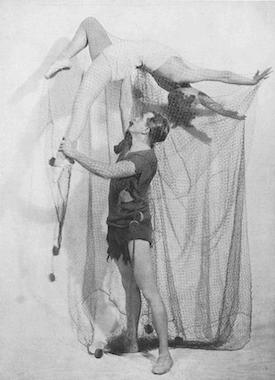
In mid-September 1927 the couture house of Irfy (Prince or Princess Youssopoff) held a dress parade at Devonshire Restaurant and it was so crowded there was standing room only.
At the same time Leslie Hutchinson (Hutch) fulfilled an exclusive engagement following a long engagement at Chez Victor. He played the piano and sang in his soft West Indian voice (he was Jamaican) his high-class songs old and new for 45 minutes including The Best Things in Life are Free. He did not use the band’s piano on the little stage but had one wheeled in through the service doors onto the floor of the restaurant itself. He was always a huge draw and all London flocked to see him. Wherever ‘Hutch’ performs London society followed.
Hutch’s engagement lasted through December 1927 and one evening it was observed that there was no crowd at all, a pleasant band and room to dance on the floor without barging into extra tables placed as special favour for some well-known patron. Hutch’s most amusing songs appeared to be new every evening.
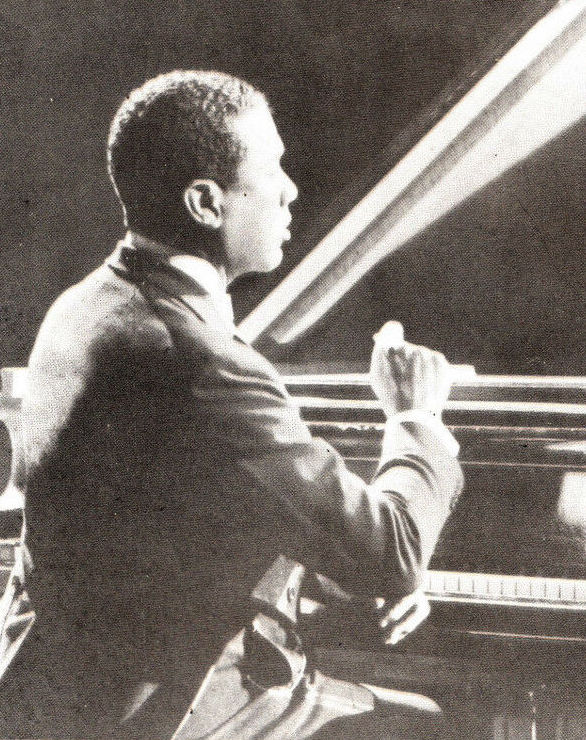
However, at the beginning of March 1928 it was announced that there was a ‘winding up order’ for the Devonshire Restaurant Ltd and eventually the company was liquidated by May 1928. At a meeting of the creditors and shareholders for the compulsory liquidation of the Devonshire Restaurant, it was reported that unsecured indebtedness was £11,182, assets were £13,421 and there were claims of £14,936.
It was observed that the restaurant was at first successful but was never filled to more than one third of capacity. It failed due to a lack of patronage, explained by diminished spending power of the public in 1927 and to severe competition.
In the midst of this process, Irfe couture (Princes and Princess Youssoupoff) staged another dress parade between 11th and 15th March 1928 where pajama suits and negligee’s were important features. Given the number of dress parades that Irfe staged at the Devonshire Restaurant, one wonders if they were investors in the project. One amusing incident occurred during the dress parade when a journalist for the Sunday Mirror wrote ‘I put, in a moment of absent-mindeness, two lumps of sugar in my tea. ‘ Gently the waiter fished one out saying ‘Madame never takes more than one.’
Another concern must have taken over the restaurant because in late December 1928 it was definately open for business. This new concern was likely to be under the direction of Mario Trapani, a London restauranteur who was perhaps associated with Giulio Trapani who had run Romano’s and the Hotel de Paris, Bray and was later involved in the Café de la Paix. Interestingly, a M. Trapani had been the original maitre d’hotel at Devonshire restaurant so it is more than likely that this was Marion Trapani.
One reporter was not happy about etiquette in the restaurant saying that although it was common for women to powder their noses in public places was it appropriate for young men to brush their hair on taking their seats at a table in the restaurant? Such action was thought to be ill-mannered and ‘another move in the effeminate behaviour of certain types of post-war youth.’ A few months later in February 1929 a wedding reception was held in the Devonshire Restaurant for Dr Claude Berridge and Joan Dickson.
In November 1930, the license for the Devonshire restaurant was transferred from Mario Trapani to Hector Jazzarino and the name was changed to Hector’s. Hector had been the maitre d’hotel at the Mayfair Hotel restaurant and Hector’s restaurant opened in mid-December 1930 with a gala dinner. Music was supplied by Alfredo Campoli and Hector’s Venetian Dance Orchestra, lunch was 6 shillings and 6 pence, a theatre dinner was 8 shillings and 6 pence, dinner was 10 shillings and 6 pence and there was dancing from 9pm – 2am
However, Hector’s did not succeed and did not last long precipitating the comment that it was ‘a hoodoo site.’ Then, in late November 1934, Hector’s re-opened as the San Marco restaurant. The new company responsible for the new restaurant was headed by Gordon W. Halsey and Umberto E. Possenti as Managing Directors with an investment of £5,000.
Gordon Hasley was an ex-cavalry officer and part of a leading family in London’s social scene. He was described as ‘a pioneer in London’s after dark glamour building’ using his influence and contacts to launch specific London night-time rendezvous. His first night-club ventures in the early 1920s at the Grafton Galleries and the Lambs Club ended in police action. He founded the Quadrant Club in 1924 and then the Florida Club in 1926 and by the early 1930s ran London’s most popular night rendezvous called the Old Florida Club. Gordon Halsey’s greatest legacy was his invention of the ‘Bottle Party’ which was a system of private parties devised to subvert the licensing laws at the Old Florida Club.
Umberto E. Possenti had originally been a waiter at Princes Restaurant and at the Savoy Hotel before he became manager of the Monte Carlo Ciro’s after the war. He also had two spells at the Casino de Floret in Le Touquet before he moved to run Ciro’s in London in 1931. Possenti saw his dream of running his own restaurant, with a specific vision, coming true when he took a look at the empty Devonshire restaurant. He gained Gordon Halsey as a fellow director who brought his vast following of the right people and Oilver Messel provided his talent to materialise his vision of recreating Venice in London in the décor.

His concept was a success and the place was regularly crowded with the right people and within five months they had paid off the original investment of £5,000. In terms of the décor one mirrored wall reflected the Grand Canal, in the alcoves golden sunlight appeared to stream through white Venetia shutters and there was a Venetian gondola cocktail bar. The Bystander remarked of the interior ‘the colouring is delicate and gay; the lighting is amazingly untiring; the details are amusing; and the whole things is genuinely original.’ The cuisine was under the direction of Possenti, the maitre d’hotel was Humbert of international fame from Ciro’s and the music was provided by Maurice Winnick, also from Ciro’s but by 1936, the music was provided by Reginald Bristol and his Orchestra with John Stevens.
Although in its early years Halsey resisted staging any form of entertainment or cabaret at the San Marco restaurant, he importing Dwight Fiske to open at the San Marco on 8th June 1936 and he also doubled at the Old Florida Club. Fiske was an American entertainer and pianist well-known for his saucy and risqué stories and songs. In April 1937 Halsey also engaged the American striptease artist Diane Raye who had been appearing at the Palladium.
It is not clear how long the San Marco continued to run but in late 1941 D&L Caterers (Alan Charles Shipley Meynell) applied for a license to provide music and dancing at Bagatelle Restaurant at Devonshire House, Mayfair. Clearly the new venue called Bagatelle must have opened in late 1941 and continued through to 1955 where thereafter it became the Cascade.
All images (unless specified in the caption) and text © copyright Gary Chapman / Jazz Age Club and must not be re-used without prior consent
Sources
The Restaurants of London by Eileen Hooten-Smith
Pall Mall Gazette 22/3/22
Sporting Times 4/12/26
Dundee Courier 7/12/26
Sevenoaks Chronicle and Kentish Advertiser 10/12/26
Westminster Gazette 17/12/26
Western Mail 18/12/26
Newcastle Daily Chronicle 21/12/26
Dublin Sport 5/2/27
Reynolds Newspaper 12/6/27
Sunday Mirror 12/6/27
Bystander 22/6/27
Westminster Gazette 23/9/27
Sunday Mirror 25/9/27
The Stage 10/11/27
Newcastle Daily Chronicle 29/11/27
Westminster Gazette 15/12/27
Yorkshire Post and Leeds Intelligencer 1/3/28
Sunday Mirror 11/3/28
Daily Mirror 15/3/28
Daily Mirror 1/5/28
Yorkshire Post and Leeds Intelligencer 1/5/28
Exeter & Plymouth Gazette 31/12/28
Leicester Evening Mail 12/2/29
Westminster & Pimlico News 14/11/30
The Bystander 27/11/34
The Bystander 18/12/34
The Bystander 29/5/35
Bystander 2/10/35
The Bystander 29/4/36
Daily Mirror 28/5/36
Gloucester Citizen 1/4/37
Daily Mirror 2/7/37
Dundee Courier 4/12/26
Dundee Courier 7/12/26
Westminster Gazette 23/9/27
Sunday Mirror 25/9/27
The Stage 10/11/27
Newcastle Daily Chronicle 29/11/27
Westminster Gazette 15/12/27
Yorkshire Post and Leeds Intelligencer 1/3/28
Sunday Mirror 11/3/28
Daily Mirror 15/3/28
Daily Mirror 1/5/28
Yorkshire Post and Leeds Intelligencer 1/5/28
Exeter & Plymouth Gazette 31/12/28
Leicester Evening Mail 12/2/29
Westminster & Pimlico News 14/11/30
The Tatler 24/12/30
Bystander 4/2/31 and 14/1/31
The Bystander 25/3/31
The Bystander 27/11/34
The Bystander 18/12/34
Bystander 2/10/35
Britannia and Eve 1/6/35
The Bystander 29/4/36
Daily Mirror 28/5/36
Gloucester Citizen 1/4/37
Daily Mirror 2/7/37
The Bystander 29/4/36
Daily Mirror 2/7/37
Westminster & Plimlico News 19/12/41

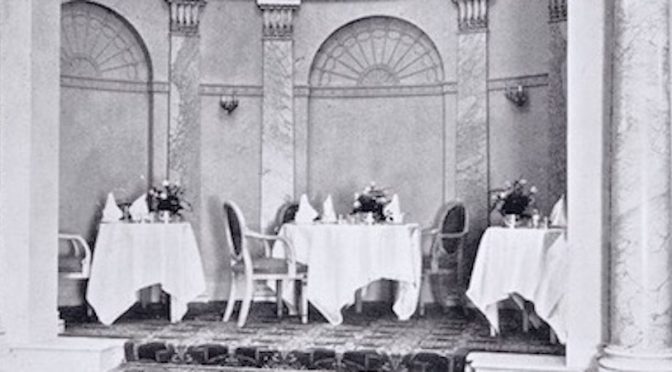
The combination of detailed original research (look at the impressive list of sources here), attention to accuracy and a very nice writing style that brings history to life, always draws me to the Jazz Age Club site. I am never disappointed. This great little article on the Devonshire Restaurant is a case in point, and there are many other highly informative articles to be found here. Congratulations and keep up the good work.